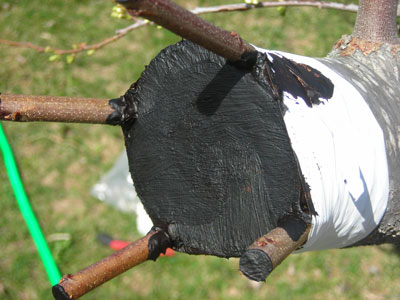 |
| In March and April, new wood was top-worked by bark grafting onto plum tree limbs at the MOFGA orchard. My mid-July all grafts were growing well. C.J. Walke photo. |
By C.J. Walke
Spring Freeze
In my last article, I wrote about shifting weather patterns and their effects on our fruit trees. I wrote that the 2012 season started about two weeks earlier than what has been considered normal, as in 2010 when we had a freeze near Mother’s Day, and that earlier bloom times meant a higher risk of blossoms and fruit buds being hit by a late spring frost or freeze when they are most vulnerable. I was hoping to avoid another frost during apple bloom, but that did not happen, so the MOFGA orchards have few fruits this year.
The culprit was a solid frost/freeze on the mornings of April 28 to 30, when temperatures dropped to 25, 27 and 28 F. Plums were in full bloom, pears were just about to flower, and most apples were at full pink. Pears and plums can tolerate temperatures a couple of degrees colder than can apples at these stages, but 25 F will kill an estimated 90 percent of apple fruit buds at the full pink through blossom stages.
The damage was not apparent immediately, although I knew it had occurred. A week after the freeze I began seeing signs. A good way to check for damage to fruit buds and young fruitlets is to cut the bud or fruitlet laterally through its widest part. A healthy fruitlet will be all green throughout; a damaged fruitlet will be brown or black in its center.
Of dozens of plum and apple buds, only a couple were still green in the center. Most noticeable was when apples bloomed about a week after the freeze, flowers were damaged or mostly brown instead of the typical vibrant white-pink. That was when I knew fruit would be minimal. My focus for the season shifted toward building soil and creating diversity, rather than nurturing young fruit.
Fungal Challenges
Fungal diseases are probably the most challenging issue for organic orchards in the Northeast, where spring rains, heavy dew and humidity keep leaves moist, creating ideal conditions for fungal diseases to take hold. Apple scab, the most common challenge, is compounded by the numerous wild apple trees that can harbor the disease, but peach leaf curl and brown rot are also common if you grow stone fruit. I prefer to focus on cultural management of disease (good pruning, orchard sanitation, building health) rather than using sulfur products, but sometimes sulfur may be the tool to slow fungal disease, giving cultural methods time to catch up.
In early June, I started receiving regular phone calls and emails from people who saw peach leaf curl developing on their peach trees, evidenced by the telltale yellowish to red wrinkled and curling leaves. This fungus overwinters as spores on and around buds. Infection begins as soon as buds start to swell and open, exposing new vulnerable tissue to the pathogen. Infections are worst when leaf development is slow due to cooler temperatures, lengthening the primary infection window while leaf tissue is young.
This was certainly the case this spring, which was very warm early, then cooled to more seasonable temperatures, causing leaves to start early but develop slowly. Most questions I received came from along the coast, where ocean breezes may have contributed to leaf wetness. Where infections were strong, sulfur may be needed to prevent infection next season. An OMRI-approved sulfur product should be applied this fall, when leaves are off peach trees, to kill spores on the tree. If infections were extreme, a second sulfur application in early spring, before buds begin to swell, will kill surviving spores.
Also in my last article, I wrote about struggling with brown rot in our hybrid plums last season. This is still a challenge but is far more manageable this year. In March and early April, I pruned out and burned branches showing canker on pencil-sized twigs. On two trees, where infection was worst, I had to remove most limbs off of main scaffold branches. Instead of drastically pruning and leaving very little vegetative wood, I cut back a few major scaffolds to younger shoots that will become new scaffolds, and top worked new wood onto the limbs by bark grafting.
In mid-July all grafts were growing well and the young shoots were taking over. I didn’t see any signs of infection on this new wood. I am still diligently removing all drops and scouting for cankers. The plums have little evidence of brown rot.
When you come to the Common Ground Country Fair, please roam the plum block, observe the oddly pruned and grafted trees, and join me for one of my talks about growing fruit trees organically in the Northeast.
C.J. Walke is MOFGA’s organic orchardist and librarian. You can address your orcharding questions to him at 568-4142 or [email protected].
